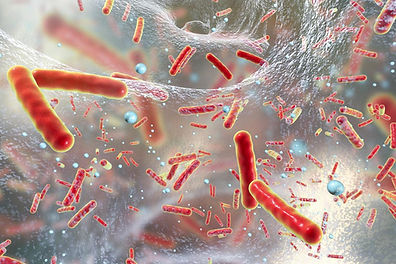The Antibiotic Tales
by Sonny Liew and Hsu Li Yang
Reviewed by Kenneth Lyen

INTRODUCTION
“The Antibiotic Tales” by cartoonist Sonny Liew and infectious diseases expert Dr Hsu Li Yang, is exactly what I wished all my medical textbooks were like; it is both entertaining as well as educational. In my youth I would have referred to such a publication as a “comic book”, but nowadays it has achieved a hoity-toity status, and we now refer to it as a “nonfiction graphic novel”.
CONTENT
“The Antibiotic Tales” starts off by placing infections in its present-day quotidian social context, then it carries you to the post-apocalyptic future set in the year 2119, where bacterial infections are resistant to all antibiotics. A young girl fell and cut herself, but the wound got infected and she developed a fever; the infection worsened despite all medical efforts, and she died.

The story returns to the present day, where grandmother has a cough with yellow phlegm, and she wants the doctor to give her an antibiotic. The doctor spends time to explain to grandmother why it is better not to give her the antibiotics. The story moves from present day to the post-apocalyptic future, showing the impending disasters resulting from current antibiotic abuse.

The last segment of the book explains in regular prose the history of antibiotics, the scientific evidence for the mechanism of antibiotic resistance, and its future impact. Advice on how to reduce antibiotic resistance and hence how to protect our future, is given.

CONCLUSIONS
“The Antibiotic Tales” is a clearly written, well-illustrated nonfiction graphic novel, based on advice given by a recognized expert in this field. The messages on how to reduce antibiotic resistance by refraining from prescribing them for most human infections, and phasing out their use in farming, is of paramount importance.
Go out and buy a copy! It is highly recommended!
Reviewed by Kenneth Lyen
25 November 2019
%20a.jpg)


The Antibiotic Tales is published by Singapore Epigram Books
ISBN 978-981-48-4570-0
Copyright 2020 Saw Swee Hock School of Public Health, National University of Singapore.
Addendum 1
OTHER NONFICTION GRAPHIC NOVELS
For those brought up on comics and graphic novels, you will be happy to note that there are a few comic books on pre-medical and medical topics. We hope that the list will keep on expanding!


These nonfiction graphic novels on medically-related topics are both enjoyable and seriously educational. They will certainly be useful for biology students, health-care personnel, and I do not see why medical students should be denied access to this genre of fun-learning!

Addendum 2
RECOMMENDATIONS TO REDUCE ANTIBIOTIC RESISTANCE AND ITS EFFECTS
I would hazard a guess that many doctors may have over-prescribed antibiotics with "good" intentions because they think this treatment will eradicate infections and cure their patients. Before we condemn them, let us look at some of the difficulties they face.
Firstly, one is unsure whether the presenting condition is really an infection. Objective clarification by quick tests is needed. If it is an infection, then we need to know if it is viral or bacterial. Most infections are due to viruses and should not be treated with antibiotics. Should it turn out to be bacterial, there may not be sufficient data to make an informed decision as to which antibiotic is best. In fact, some bacterial infections may not need antibiotics, as the body’s own immune system can handle the organism very well, thank you!
Perhaps some doctors are a bit impatient and instead of following the evolution of the illness, they jump into prescribing antibiotics too early. Sometimes it is the patients or their relatives who pressurize doctors to prescribe antibiotics. And not wanting to offend them, doctors might acquiesce to their demands. No, I am not trying to excuse doctors for over-prescribing antibiotics; indeed they should take much of the blame.
To help doctors make a more rational decision, here are some suggested strategies for managing the over-prescribing of antibiotics:
1. Invent some noninvasive ways of accurately diagnosing infections hopefully with rapid results. Currently there are rapid diagnostic tests for influenza, taking only 15 minutes for the results. There are no comparable tests for bacterial infections. Maybe companies might like to develop noninvasive tests capturing the expectorated breath and its contents from coughing patients into a syringe or balloon, and then quickly analysing the “achoo-ed” materials.
2. From the analysed materials decide if antibiotics are needed, and if so, which is the most effective antibiotic with the least side effects.
3. If the bacteria isolated turns out to be resistant to all current antibiotics, then we must develop newer antibiotics. For example, tuberculosis (TB), according to the World Health Organisation, affected 10 million people and killing 1.6 million in 2018. Unfortunately, in some parts of the world, TB has become resistant to all the older antibiotics. In August 2019, the US Food and Drug Administration has approved three anti-TB drugs, bedaquiline, linezolid, and pretomanid for general use. Hopefully this can solve the problem of antibiotic resistance.
4. Prevention is better than cure. The current BCG (Bacille Calmette-Guerin) vaccine is only 70-80% effective. Improving on this vaccine can save more lives. Other diseases might also be prevented by developing new vaccines.
5. Expand the spectrum and use of probiotics. We live in equilibrium with our micro-organisms. Some may be beneficial for us and protect us from more serious illnesses. It is important to identify the advantageous ones and help promote their presence inside our body.
The challenges to redress the problem of antibiotic resistance requires urgent action, otherwise the post-antibiotic apocalypse depicted by Sonny Liew and Hsu Li Yang will become a reality sooner than we envisage.
Kenneth Lyen
25 November 2019
